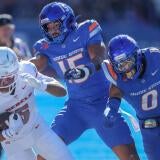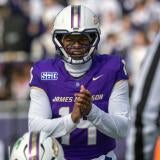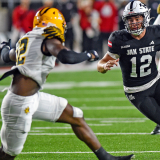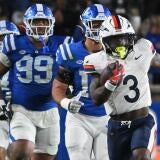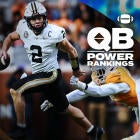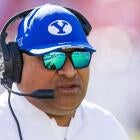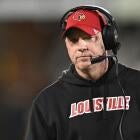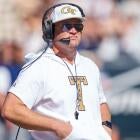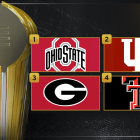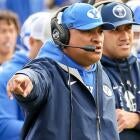The birthplace of the Pistol Offense is a carpeted, 10-foot-by-30-foot stretch in the front of the Nevada football locker room that has probably been walked over a million times in the past eight years. One morning in the spring of 2005, Wolf Pack head coach Chris Ault -- coming off a 5-7 season -- led his running backs coach Jim Mastro and three other Nevada assistants with him from their coaching offices down a flight of stairs at 6:30 a.m. to the ground floor of the Wolf Pack football building.
Ault had an idea, an idea that less than a decade later has had a profound influence not just on college football, but the NFL as well. What grew from a six-hour session that began that morning in Reno a few weeks before the start of spring ball has had an impact that has even helped spark the San Francisco 49ers and their young standout quarterback Colin Kaepernick on a Super Bowl run.
"I was disgusted with our run game," Ault recalled to CBS on Wednesday morning. "I felt our football program needed an identity. Honestly, it was gonna be a feast or famine with this thing."
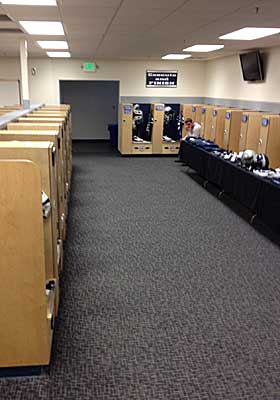 |
| Where the Pistol offense was born. (US Presswire) |
The 2004 season was Ault's first since returning to the sidelines after almost a decade out as Nevada's athletic director. Ault's coaching persona within the business had been that of a guy who wasn't afraid to trek out on his own path.
From the mid-'70s through the late '80s, Ault, a former Nevada quarterback, was one of the few coaches in the nation, at any level of college football or in high school, who ran the Wing-T offense. Then, in 1988, when Ault realized that the Wolf Pack football program would at some point in the not-to-distant future move from the 1-AA level to the major college level, his program evolved to the 1-back offense after studying the scheme that Dennis Erickson had employed at Idaho. Ault's teams didn't throw it as much as Erickson's but the Pack still went on to pile up wins and become one of the nation's most prolific passing teams before he walked away from coaching after the 1995 season.
"In 2004, what I learned from being out of the game was that to be able to win championships, you gotta be able to run the rock."
Ault also was convinced that if Nevada was going to thrive it had to come up with signature style. Something that made the Wolf Pack stand out. "We needed something to make Nevada special," Ault said. "We don’t have the resources you need to compete at this level."
At the same time, Mastro, his running backs coach and the Wolf Pack's offensive line coach, had been trying to sort out issues related to the inconsistent drops of their quarterback. "We always kinda wondered where was he gonna be [depth-wise in the pocket]," said Mastro.
Mastro and the other Nevada coaches had tried to talk Ault into going to the shotgun. "He hated the shotgun because he said the running game is all east and west," recalled Mastro.
Ault's idea was some variation of the shotgun, but not quite the shotgun, which he knew translated into something of a math problem as it related to the dynamic between a quarterback and a tailback aligned behind him. "There was no film," said Ault of his vague idea. "Nobody to talk to. I wanted to see where the mesh could be if it could be done."
Ault figured the locker room was the best spot he had to do some experimenting. "We needed room and that [the locker room] had to do since we didn’t have a staff room," said Mastro, who added that sub-freezing temperatures made the practice field less of an attractive option, "and our weight room wasn’t very big, either."
Ault had Mastro tamp down duct tape to give them an idea of how the spacing might unfold. The timing -- and footwork -- were critical. Ault acted out the part of the quarterback. Mastro played the role of the running back. Ault first lined up 2 yards behind the center. Didn't work. Then 2 1/2 yards behind. Still didn't work. Tried 5 yards deep. Nope, that didn't flow, either. Complicating matters was the fact that they weren't actually running anything full speed since the locker room was too small. Finally, they realized that if the quarterback was lined up 4 yards behind the center and the back was 7 yards deep, everything seemed to work.
"We tried to time everything out," recalled Mastro. "We walked through everything about the run game. We talked about the protections. 'What could the back see. What couldn’t he see? With certain routes, how is the back gonna see the ball if we’re doing silent count? OK, maybe the back has to see the guard’s hand.' We had to make sure we had all the answers."
Said Ault, a Hall of Fame coach who also is credited with developing what is now known as the "jailbreak scree" as well as the current college football overtime format, "my staff must've thought I was crazy."
He's right.
"I'm thinking to myself the whole time -- and this is going on for hours and hours -- 'This is ridiculous. He's totally lost it. This is so stupid. We're gonna get fired,'" said Mastro. "It seemed like everything that was wrong with football."
Ault told the staff this would be the formation the team would use the entire spring. There would not be one snap taken from under center by the quarterback. That led to some pretty dubious results.
"We had snaps on the ground, to the left of the quarterback, to the right, over his head," Mastro said. "For about five days, it was atrocious. But then by about day seven, we started to see some things where you come away going, 'Maybe, there is something to this thing.' The play-action game was great and the quarterback was having no problems getting depth on his drops."
An added benefit of the new offense Ault learned from his linebackers coach that the defense was having a hard time seeing the Wolf Pack running back, 5-foot-8 B.J. Mitchell behind 6-5 QB Jeff Rowe. That gave Ault the idea that he should start watching practice from the defensive side. "I'd never done that before," he said.
By the second week of spring practice, a few of the Nevada assistants suggested to Ault that they stay in their base offense and just use the new formation as a change-up.
"Absolutely not," said Ault.
Ault laughs now at the fact that no one, not the local media or anyone outside his program who dropped by practice noticed the different look of the Nevada offense. "Not one person asked me about the formation," he said. "They all thought it was the shotgun. Thank God they didn’t do the math or they’d probably have tried to have me committed."
It took rival teams awhile to note the change to the Pistol, too, but the new look revved up the Pack's ability to run the inside zone, the power and the counter. And, to clear up any misconceptions, Ault says, there was no zone read component to the Pistol. That came in Year Three. But the debut season of The Pistol worked out pretty well for the Wolf Pack. They went 9-3 and won the WAC, winning eight of their last nine games as they got the timing of the offense down. Mitchell won WAC Player of the Year honors, more than tripling his rushing totals from the previous season.
Year Three of the Pistol is when Nevada incorporated the zone read. Starting QB Nick Graziano went down with an injury. Backup Colin Kaepernick, a spindly redshirt freshman, took over and amassed more than 440 yards of offense in a little over a half against Fresno State. One week later, making his first career start, Kaepernick led the Pack against Boise State, a 26-point favorite. Nevada ended up losing 69-67 in four overtimes but Ault had found a star and his offense was about to take another big step forward.
"He was a Wing-T QB in high school, and he threw it side arm," Ault said. "He had that pitching throw. You could see he had decent speed. We had him in camp. I probably wouldn’t have offered him off film. We didn’t offer him out of camp. But we knew he probably could be a good free safety or wide receiver if he couldn't play quarterback. He was such a great kid, very attentive. We didn't know he was getting ready to put his cape on, and it’s now with a big K right in the middle of it."
Kaepernick's rise in the NFL in just his second season has emerged as one of the big storylines of the postseason. The rise of the offense that the QB is most associated with has become something even larger than that since the Pistol has sprung up all over the league. (Ault says he thinks no team in the league runs it better than Washington does with Robert Griffin III.) But with it has come skepticism from football traditionalists who call it a fad or gimmicky and point to RGIII's injuries as evidence why the Pistol -- and the QBs who run it won't last.
Ault isn't arguing that point. "You can't run the quarterback as much in the NFL as you can in college, but what is 'too much?' Five times a game? Four times a game?"
He says the running back should get the bulk of the carries in the Pistol -- even if he has a quarterback as fast as Kaepernick. But the things that make it such a headache for rival defenses is the bite the Pistol look gives to the play-action game and forces opponents to practice defending it.
"I get that you don’t want your quarterback who makes multimillions of dollars carrying the ball 16 times a game. But I also know that I've seen quarterbacks throw it 40 times a game and face these blitzes and take more vicious hits than Kap ever has."
Ault's teams at Nevada ran the Pistol seven seasons right up till him stepping down from the program last month. He says the only time his QB ever was injured was when Cody Fajardo ran into his own tight end in practice on a keeper, forcing him to miss one game last season. "Our QBs learned to go down or get out of bounds," Ault said.
The 66-year-old coach is hoping to make the trip to New Orleans for the Super Bowl to root on his old QB next week. After that, he's not sure what he'll do. A coaching job in the NFL in some capacity would interest him. "I’m not going fishing, I can tell you that," he said. "I won’t be at the lake.
"If there is something I can bring to the table, I’d be interested."
Mastro laughs now when he recalls how crazy he thought his mentor was that day in the locker room back in '05. Although he later admits something that tells you maybe he knew the old man was on to something.
"Somewhere, I still have that roll of tape that we used."



